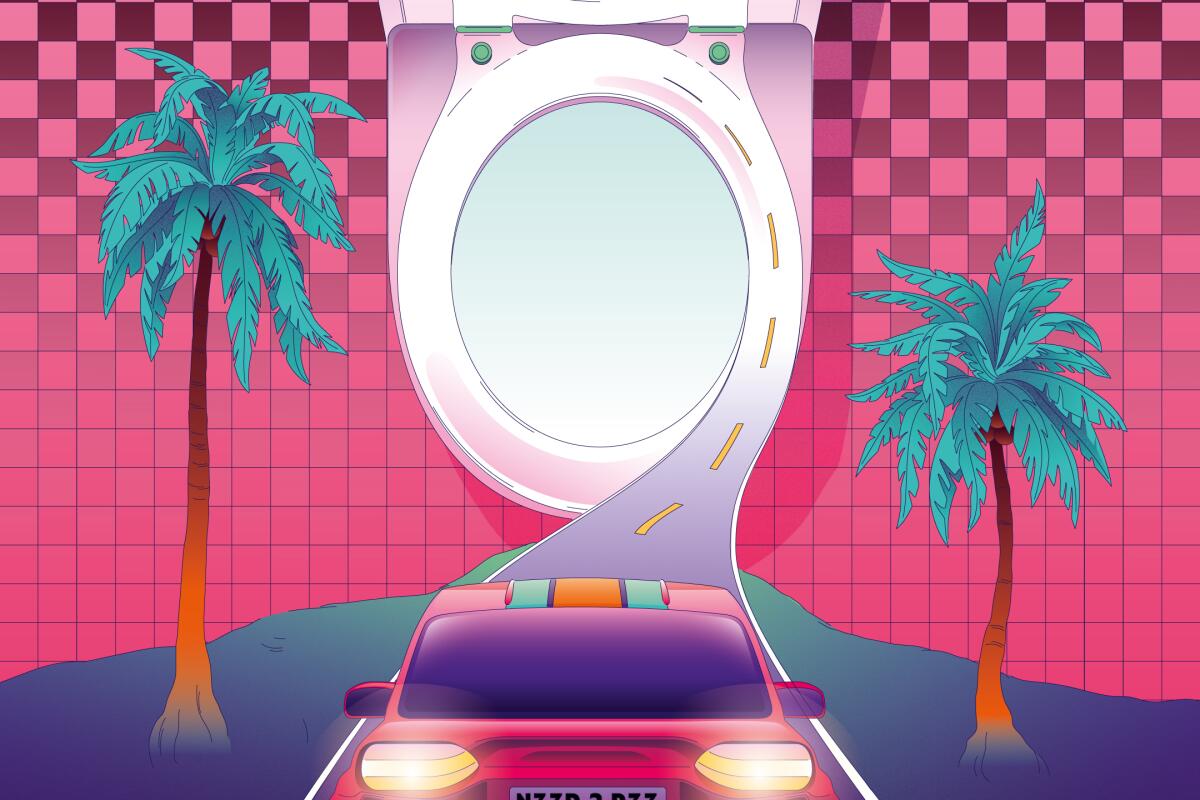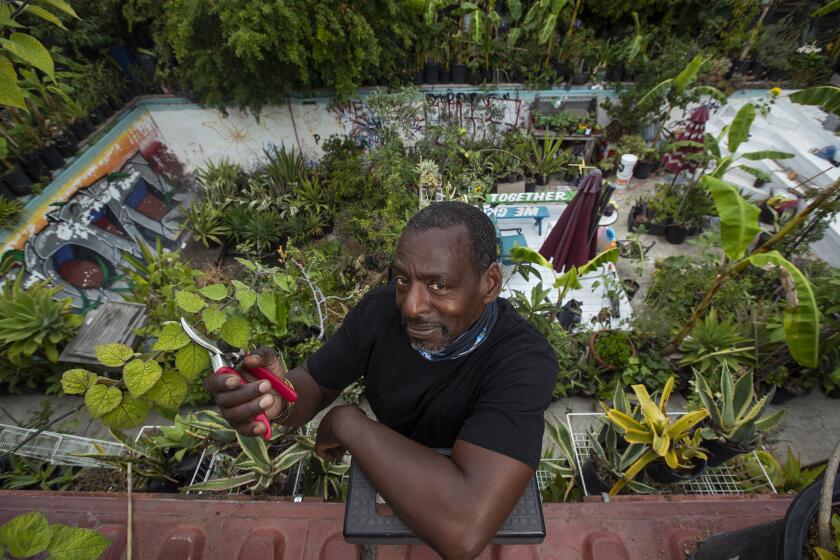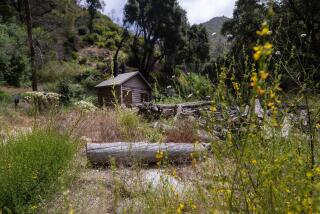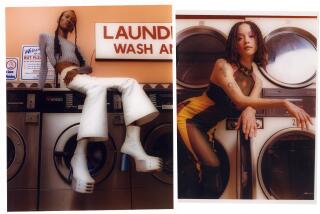Full bladders, closed bathrooms. Strategies for peeing while out during coronavirus

- Share via
Remember the good old days (a few months ago), when you could leave your home for the day with a tall tumbler of coffee and a car well-stocked with water, confident in the knowledge that when your bladder came calling, you could find quick and easy relief at the nearest coffee shop, gas station or fast-food restaurant?
Because after a couple of hours, you were likely ready for another Starbucks Nitro Cold Brew anyway, right? At least that’s how it worked in my world, where regular caffeine was such a workday requirement that by the time I got home, the interior of my car was full of empty cups.
In truth, I probably owe my caffeine addiction to my bladder: I had to buy a new coffee every few hours so I could justify using a coffee shop’s public bathroom when I was working outside the office.
But the easy days of ubiquitous public restrooms are but memory, thanks to the coronavirus pandemic and the lockdowns that have shuttered the seating areas — and toilets — of many coffee shops and restaurants.
Testing sewage for the coronavirus may tell scientists how much disease is in a community — and when the virus has finally gone away.
Even the old reliable go-to, the gas station, has become an iffy proposition.
Is there any dance more urgent than racing into a gas station in pursuit of a restroom only to discover it’s closed to the public and trying to think, “What do I do now?” over the screams of your near-bursting bladder?
The staff at the Central 76 station in Riverside, just off the 91 Freeway, have seen that look more than once. “Lots of people come here from other stations saying, ‘I have to go!’” said assistant manager Cesar Mungaray. “And if we notice people heading to the wall [outside], we go to the door and shout, ‘Hey, we have restrooms open inside,’ because when they have to go, they’ll go outside.”
So maybe it isn’t my imagination, that whiff I keep smelling in parking lots these days.
In fact, I now have a far better understanding of what homeless people have been facing for years: If people won’t let you in, where can you go?
The problem comes at a time when, for many of us, taking a drive seems like the last fun, safe, socially distanced thing we can do these days to get out of the house. But any drive that takes us too far from home leads right back to the problem at hand: where to go when nature calls.
Sharokina Shams, spokeswoman for the California Restaurant Assn., says many food establishments have closed their restrooms to minimize coronavirus exposure for their employees.
Not an unwarranted concern, considering that the coronavirus has been found in the raw sewage at Yosemite National Park.
A basic reality, however, is that restrooms get dirty, and surfaces that get lots of touching, such as doorknobs, sink handles and toilet seats, need to be cleaned. Guidelines from the Centers for Disease Control and Prevention are demanding — requiring plenty of disinfectants and cleaning supplies — which can be difficult to manage when staffing is thin. Complicating matters is when the on-site restrooms are also the only available restrooms for employees to use.
And what about a business owner’s liability if an employee gets sick after cleaning a restroom? Easier just to shut it down.
For Nahal Noorzady, co-owner of the 14th Street Chevron and car wash off the 91 Freeway in Riverside, closing bathrooms is a struggle between her sympathy for travelers and basic dollars and cents.
Chevron has instructed its stations to keep restrooms open for customers, she said, but they have closed one of their two restrooms to the public, reserving that for employee use.
Noorzady says she understands the need for public toilets, but paper towels and cleaning supplies have become more expensive and harder to buy. “I used to be able to buy a four-pack of paper towels for $23.99. Now I can only buy one pack at a time, and it costs $45.” Noorzady added: “If I can’t buy soap, I’ll have to close my restrooms.”
My friend tells me to do what truck drivers do — sit in my car and reach for a portable urinal. That’s what the Tinkle Belle is for, she said. (For the uninitiated, the Tinkle Belle is one of many clever devices on the market that allow women to urinate standing up, without baring all.) But this is not a happy thought. What if I misalign my “female urinary device” and send urine streaming all over my shoes and floor mat a few minutes before my next interview? What if someone walks by my car and happens to glance inside?
Give me a good bush to stand behind, or even a deserted field, and I’m OK, but out in a parking lot or a city street … aargh. Somebody must have a restroom open somewhere.
And therein lies the rub. A few places do, based on my unscientific sampling these past few weeks, but if you’re on the freeway and you have to go, you don’t want to start guessing who might be open and make the wrong choice. After a few of those near-miss encounters, your bathroom quest can become a little crazed.
If you are lucky enough to find a public bathroom, remember some common-sense strategies, inspired in part by the CDC: Wear a mask, social distance if there’s a crowd, and try not to unnecessarily touch anything — especially your face.
If possible, use a paper towel or tissue to open and close doors, then toss it in the trash — not the toilet, where it can cause a clog. (You might want to carry extra tissue or travel soap with you, as you never know when TP or cleaning supplies may be scarce.) Ideally, use hot water and soap to clean your hands on the way out.
And don’t linger; the longer you stay, the more exposed you are to any airborne germs from the last toilet flush or visitor. Finally, use hand sanitizer when you get back to your car.
So potential solutions come down to dehydration (which isn’t foolproof) or lots of strategic planning.
L.A. gardening guru Ron Finley filmed his gardening MasterClass long before the coronavirus and Black Lives Matter protests. But his message is right on time.
Pepe Garcia, assistant general manager of the solids divisions in the L.A. City Public Works Department, drives into Los Angeles from Perris every day, a good 75-mile trip one way, and he’s opted for strategic planning.
“After 30 years of traveling the same roads, you find little pit stops along the way,” he said. But when the pandemic came, and his go-to stops were closed, he had to move to Plan B: He’s identified a few places along his route that he knows will be open and always stops there now on his way to work, even if the need is not urgent.
“I’m getting older, and I don’t hold it like I used to, so I just anticipate that I won’t be able to go all the way without stopping,” he said. “I’ve got it down to a science; it’s become routine. Otherwise, it’s just a guessing game and you have to bounce from gas station to station until you find something.”
So here is my unscientific anecdotal advice about managing your bladder during the pandemic:
1. Do some shopping
These days, the most reliable place to find an open restroom is in grocery stores or big-box stores like Target, Costco or Trader Joe’s. Of course, this means finding a parking space, sprinting through the parking lot and then praying there’s no line, but you can be reasonably certain that these stores will keep their restrooms open and clean.
2. Visit a park
Most city buildings are closed to employees and the public at large, but park bathrooms are still open, at least in the city of Los Angeles, said spokeswoman Rose Watson. The city lists its parks and their addresses on its website, if you want to bookmark those locations for easy searching, but be warned, small “pocket parks” don’t usually have restrooms, Watson said. Good rule of thumb: If the park is big enough to have a recreation center, it will also have restrooms, which are typically open from dawn to dusk, she said. And — bonus! — those restrooms are usually near the parking lots, so you shouldn’t have to run too far to get relief.
California Botanic Garden is the new name for the state’s largest garden of native plants. Virtual events show how to incorporate these plants into our daily lives.
3. Pre-scout your route
Most digital maps show businesses along the freeways, so make a note of exits that lead to a sure pit stop and then call ahead to make sure.
4. Invest in a portable urinal
It can’t hurt to have a screw-top urinal in your car, for those absolutely desperate moments when you can’t find any other place to go. One of Amazon’s top picks is supposedly spill-proof and even has a glow-in-the-dark lid so you can find it at night. Women should investigate the vast new world of female urination devices or “pee funnels,” such as the Tinkle Belle, Amazon top-rated Sunany (with a funnel tip small enough to fit inside an empty water bottle), the GoGirl (No. 1 bestseller on Amazon), the Easy Peezy and the Shewee (one of the earliest FUDs on the market and now available in 10 colors!). There are also plenty of compact, portable toilets on the market, some for as little as $19.99.
5. Look for rest stops
State-maintained rest areas are still helpful on long hauls, provided they’re not closed for maintenance. This is where Garcia’s advice comes in handy: Go whenever you can, because who knows when the next opportunity will show up.
6. Pack a bag
Because accidents do happen, it’s especially smart these days to have a little bag in your car with wipes, tissues, plastic bags (one for damp garments, another for soiled tissue) and a change of clothes. (And maybe even shoes, in case your pee funnel slips.) Some extra hand sanitizer would be helpful too, along with a towel to wrap around yourself if you have to go somewhere in wet pants to change.
And remember, things could be worse. You could never have packed a bag at all.
More to Read
Sign up for The Wild
We’ll help you find the best places to hike, bike and run, as well as the perfect silent spots for meditation and yoga.
You may occasionally receive promotional content from the Los Angeles Times.












